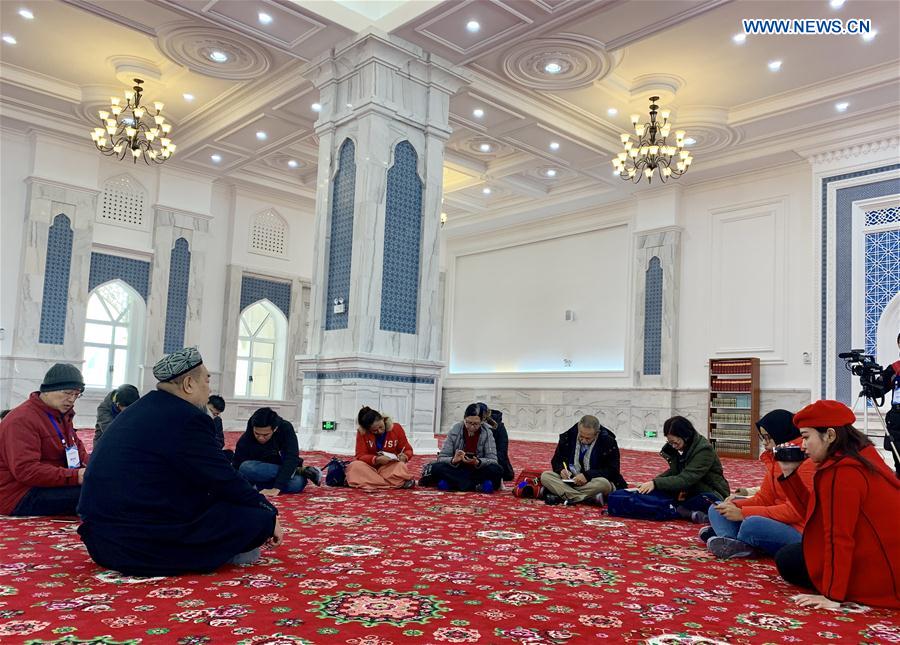 ?
?Journalists from Indonesia and Malaysia conduct an interview at an Islamic college in northwest China's Xinjiang Uygur Autonomous Region, Feb. 23, 2019. A group of journalists from Indonesia and Malaysia visited the Xinjiang Uygur Autonomous Region from Feb. 22 to 27 to interview the local people and find out about the region's development and how it implements policies on de-extremism. The visit by 11 journalists, as part of the ASEAN Elites China Tour 2019, followed a series of tours by overseas media and foreign diplomats to Xinjiang. (Xinhua/Zhou Ye)
URUMQI, Feb. 28 (Xinhua) -- A group of journalists from Indonesia and Malaysia visited the Xinjiang Uygur Autonomous Region from Feb. 22 to 27 to interview the local people and find out about the region's development and how it implements policies on de-extremism.
The visit by 11 journalists, as part of the ASEAN Elites China Tour 2019, followed a series of tours by overseas media and foreign diplomats to Xinjiang.
The journalists visited vocational education and training centers in Kashgar, Shule County, and Hotan County, where they were deeply impressed by spacious buildings and well-equipped lodging facilities.
Nugroho Fery Yudho, a senior editor from Kompas, an Indonesian paper, who visited Xinjiang for the first time, commended China's efforts on de-extremism and countering terrorism. He said what he saw in Xinjiang was not as reported by some news outlets alleging that people were being locked up at the centers.
The journalists observed classes at two preschools at the Naizerbag Township in Kashgar, where children aged three to six attend for free. The kids are taught in both Chinese and the ethnic Uygur language.
At the Id Kah Mosque in Kashgar and Gamai Mosque in Hotan, religious staff led the journalists on tours.
These mosques are old but well-preserved and are places where Muslim believers honor their religious customs, said Asmaliza Binti Mansor, assistant editor at Sinar Harian, a newspaper in Malaysia.
Also her first visit to Xinjiang, Asmaliza Binti Mansor said many news reports about Xinjiang are done in a negative way, and the tour is good for her to see Xinjiang as it is.
Zulfiani Lubis, the chief editor of Idntimes.com, said she has spent 16 years focusing on reports about terrorism.
Vocational training is a common way to counter terrorism, extremism and separatism, she said. "I found through interviews that the way extremist thoughts infiltrated China was very similar to how it infiltrated Indonesia, which is all through the internet."
OBSERVING HERITAGE
As a gateway for China to open to the West since ancient times and a key region on the ancient Silk Road, Xinjiang is home to long-term exchanges among people of different ethnic groups. At the regional museum, journalists learned about the history, culture and folk customs of the region.
Dating back more than 2,000 years, Kashgar's old town underwent a 7-billion-yuan (about 1.05 billion U.S. dollars) renovation, making dilapidated houses earthquake-proof while maintaining the traditional style.
Asmaliza Binti Mansor, the Malaysian journalist, is fond of visiting historical sites. She said she was amazed at the sharp contrast between what she saw in Kashgar, the tidy roads and bustling streets, and the run-down architecture in the old archives.
The tradition of making musical instruments dated back 150 years in Shufu County, where dozens of musical instruments are made in family workshops. It has the only museum in China dedicated to musical instruments of ethnic minorities.
Yudho, the Indonesian journalist, was fascinated by the purity of the tambur and the fine craftsmanship in the musical instrument's making. He bought one as a souvenir.
POVERTY REDUCTION EXPERIENCE
Xinjiang is the largest in China in terms of landmass and also one of the less developed areas in the country. The journalists were impressed by the successful experience the region has achieved in poverty reduction.
At a poverty-relief relocation site at the Turugart port in Wuqia county of Kizilsu Kirgiz Autonomous Prefecture, the journalists visited Gulnur's new home. The house is decorated with Kyrgyz-style carpets and tapestries, and Gulnur, the hostess, treated the journalists with hand-made, traditional delicacies.
"I learned that her family once led a difficult life in the border area, and now they are better off after moving here," said Rizki Akbar Hasan with Liputan6.com in Indonesia.
Gulnur is among the 136 households of Kyrgyz herders, who once lived a nomadic life in the mountainous county of Wuqia, in the far west of Xinjiang. They had to move from place to place to wherever there were water and grass for sheep and cattle.
Thanks to a resettlement program, Gulnur and her family moved to their new home and settled down in 2016. Besides better living conditions, they now have access to resources such as education and healthcare, which were once unavailable.
Also in Wuqia, the journalists visited the Tuofeng camel fur company. Established in 1996, the company buys camel hair from areas such as southern Xinjiang and Kazakhstan, makes them into hats and clothes and sells the products to Russia and Central Asian countries.
Yohana Margaretha, from Indonesia's Metro TV, said Indonesia also supports small and micro companies as a way to help people shake off poverty.
"It's great to see that these camel fur products can be sold to places as far as Central Asia," she said. "The newly-built villages here are as beautiful as cities, and I wish I could have more time to look around."















